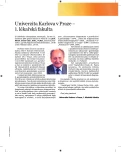Characteristics of sexual maturation in girls in Bratislava region
Authors:
Z. Kosibová; Z. Nižňanská; M. Gerová; M. Korbeľ
Authors‘ workplace:
I. gynekologicko-pôrodnícka klinika LF UK a UNB, Bratislava, Slovenská republika, prednosta kliniky prof. MUDr. M. Borovský, CSc.
Published in:
Ceska Gynekol 2014; 79(4): 289-294
Overview
Objective:
Evaluation of puberty onset and menarche in girls in Bratislava region in the years 2006–2007 and 2011–2013.
Design:
Regional retrospective epidemiological study.
Setting:
1st Department of Gynaecology and Obstetrics, School of Medicine, Comenius University and University Hospital Bratislava, Slovenské republika.
Methods:
A study in two periods was performed. The first was in the years 2006–2007 and the second in 2011–2013. Together 217 girls aged 7–16 were enrolled. Secondary sexual characteristics according to Tanner were evaluated. Ultrasound examination of the uterus and ovaries was performed. The results were statistically evaluated by software Statistical Package for Social Sciences (SPSS) by age, and compared to results of Slovak study held in the years 1976–1980.
Results:
The mean age of menarche onset of girls in the group was 12.37. Pubarche and adrenarche onset were at 10.7 and 11.7 year respectively. Thelarche onset was at 10.9 year. Development of secondary sexual characteristics significantly correlated with ultrasound parameters of internal genitalia and with age of menarche. Average ultrasound parameters increases with age to 15 years. Significant changes were for average anteroposterior uterine size in 11 and 13 years old girls, for proportion corpus/cervix of the uterus in 9 and 11 years old girls and for average ovarian volume in 9, 11, 14 and 15 years old girls.
Conclusion:
The results from our study comparing to those from study held in 1976–1980 shows continuous secular trend in Bratislava region.
Keywords:
age of menarche, secular trend, puberty, secondary sexual characteristics
Sources
1. Bau, A., M., Ernert, A., Schenk, L., et al. Is there a further acceleration in the age at onset of menarche? A cross-sectional study in 1840 school children focusing on age and bodyweight at the onset of menarche. Eur J Endocrinol, 2009, 160, p. 107–113.
2. Hořejší, J., Šnajderová, M. Puberta a její poruchy. In Cibula, D., Henzl, M., Živný, J. Základy gynekologické endokrinologie. Praha: Grada, 2002, s. 91–119.
3. Danubio, ME., Sanna, E. Secular changes in human biological variables Western Countries: an updated review and synthesis.J Anthropol Sci, 2008, 86, p. 91–112.
4. Dvořák, D. Gynekologie dětí a dospívajících. In Roztočil, A. Moderní gynekologie. Praha: Grada 2011, 1, s. 140–184.
5. Kanji, GK. 100 Statistical Tests. 3rd Ed. London: SAGE, 2006, p. 242.
6. Kaplowitz, PB. Link between body fat and the timing of puberty. Pediatrics, 2008, 121, 3, p. 208–217.
7. Kay, V., Chambers, CH., Foster, WG. Reproductive and developmental effects of phthalate diesters in females. Crit Rev Toxicol, 2013, 43, p. 200–219.
8. Košťálová, Ľ. Fyziológia puberty. Pediatr prax, 2007, 3, s. 135–140.
9. Kovalčíková, J. Vstup do menarché a priebeh menštruačného cyklu u žiačok – učníc na Slovensku I. Čs Gynek, 55, 1990, 1, s. 6–11.
10. Krásničanová, H., Lesný, P. Kompendium pediatrické auxologie. Čes-slov Pediat, 2001, 7, s. 412–416.
11. Krásničanová, H., Veselá, M. Vztahy hmotnost-výška a menstruační cyklus u pacientek s mentální anorexií. Čes- slov. Psychiat, 2006, 102, 2, s. 66–72.
12. Langer, L. Súčasné pohľady na faktory ovplyvňujúce nástup puberty. Prakt Gyn, 2005, 12, 4, s. 165–169.
13. Luha, J. Testovanie štatistických hypotéz pri analýze súborov charakterizovaných kvalitatívnymi znakmi. Bratislava: STV, 1985, s. 160.
14. Luha, J. Štatistické metódy analýzy kvalitatívnych znakov. Forum Statisticum Slovacum, 2/2006, Bratislava: SŠDS, 2006, s. 2–20.
15. Luha, J. Metodologické zásady záznamu dát z rozličných oblastí medicíny a zásady ich kontroly. Forum Statisticum Slovacum 1/2010, Bratislava: SŠDS, 2010, s. 16–38.
16. Michálek, J. Deti a obezita. In Krahulec, B., Fábryová, Ľ, Holéczy, P., et al. Klinická obezitológia. Brno: Facta Medica, 2013, s. 284–306.
17. Riffenburgh, RH. Statistics in medicine. 2nd ed. Amsterdam: Elsevier Academic Press, 2006, p. 622.
18. Šašinka, M., Furková, K. Hodnotenie puberty. Via pract, 2007, 3, s. 114–116.
19. Šnajderová, M. Nadbytek estogenu v dětském věku. In Kučera, E., Fait, T. Hyperestrogenní stavy v gynekologii. Praha: Maxdorf, 2011, s. 74–103.
20. Steingraber, S. The falling age of puberty in U.S. girls: What we know, what we need to know? San Francisco: Breast Cancer Fund, 2007, p. 16–34.
21. Vignerová, J., Bláha, P., Brabec, M. Dlouhodobé změny růstu české dětské populace. Čes-slov Pediat, 2005, 60, s. 274–280.
Labels
Paediatric gynaecology Gynaecology and obstetrics Reproduction medicineArticle was published in
Czech Gynaecology

2014 Issue 4
Most read in this issue
- Prebioptic methods in the cervical cancer screening
- Pregnancy and delivery in patients with an implanted shunt for hydrocephalus
- Principles and limits of clinical methods in the diagnosis of fetal hypoxia
- Tuberculosis in pregnancy:a challenging differential diagnosisfor inflammatory bowel disease
